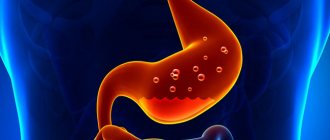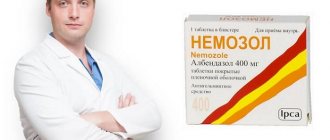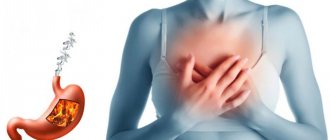Stomach problems are one of the most common ailments that plague a huge number of people. Sometimes it is severe pain, sometimes constant nausea, and often vomiting and lack of appetite. There are many reasons for the occurrence of such problems, but one of the main reasons why a person feels discomfort is increased stomach acidity; you can learn more about the symptoms of this pathology.
Causes
Increased stomach acidity can provoke the development of severe pain syndrome
Before moving on to the main symptoms of increased stomach acidity, it is worth saying what gastric juice is and why pathology can develop. Gastric juice is the juice that is produced by various cells of the mucous membrane of this organ. Thanks to this juice, the normal digestion process occurs and the necessary nutrients are absorbed in the body. One of the main indicators of normal stomach function will be the concentration of acid in gastric juice. Very often people experience increased acidity, which can be caused by the following reasons:
- Poor nutrition. Abuse of alcohol, spicy and fatty foods, large amounts of food consumed or, conversely, irregular meals in small portions
- Poor chewing of food. Often, when a person eats in a hurry, many large unchewed pieces of food end up in the stomach, which are very difficult to digest. And in order to do this, the stomach is forced to produce more gastric juice, and as a result, increase its acidity
- Long-term use of certain medications that have a harmful effect on the gastric mucosa. Such drugs usually include paracetamol, aspirin, hormonal medications, analgin
- Stress. Severe emotional overload, as well as constant tension, can provoke the development of various health problems in a person. Very often, the first thing this affects is the gastrointestinal tract, since in most cases, when experiencing stress, a person forgets to eat, or takes a large amount of alcoholic beverages, which have a detrimental effect on the gastric mucosa
- Smoking. Tobacco smoke, despite the fact that it is most concentrated in the lungs, negatively affects the normal functioning of the stomach. Smokers often have digestive problems. Tobacco smoke causes the greatest harm when a person smokes on an empty stomach. It is at this moment that toxic substances have the greatest effect on the mucous membrane, provoking increased secretion of gastric juice and an increase in its acidity
- Helicobacter. More recently, scientists discovered this bacterium, which is the cause of such diseases. Like stomach ulcers and gastritis. Helicobacter is one of the few bacteria that, due to its good adaptive abilities, can live in the stomach. If it enters the body, specific enzymes will be produced that damage the gastric mucosa. Separately, it should be noted that this bacterium is transmitted through saliva. Therefore, it is easy to become infected with gastritis by drinking from the same cup with someone who has it.
- Infection. After a person has suffered an infectious disease, be it even a simple influenza virus, complications may arise that sometimes affect the gastric mucosa. Any infection can spread very quickly throughout the body and find a further place for development in absolutely any organ.
Despite the fact that almost every person knows the main reasons why gastritis can develop and the content of hydrochloric acid in the gastric juice can increase, few people pay attention to them until the problem hits them.
Epidemiology
According to statistics, gastritis is registered in 80-90% of adults. Helicobacter pylori associated is recognized as the most common; it accounts for 90% of all diagnoses of chronic hepatitis. The most dangerous form with a high percentage of malignancy is atrophic, occurring in 5% of cases in people under 30 years of age, in 35% in patients 30-50 years of age, in 70% in patients over 50 years of age.
In children, the disease most often develops during puberty and at the age of 4-7 years, when the child is most susceptible to infectious and viral diseases.
Main symptoms
Increased acidity very often occurs against the background of an imbalance in the process of regulating the acidity of the juice, as well as its neutralization. That is why a person may experience the following symptoms:
- Heartburn. It usually occurs either immediately after eating, or at the moment when a person takes a lying position. Heartburn is the reflux of stomach acid into the esophagus. The juice irritates the mucous membrane and therefore a strong burning sensation occurs, which is localized mainly in the Adam's apple area
- Belching, which usually tastes either sour or bitter. Moreover, it appears mainly after eating
- Pain. It can be either strong or not very strong. It occurs at the moment when acid enters the duodenum, or rather into its lumen. In addition, another cause of pain will be acid getting into damaged mucous areas. At the moment when their interaction occurs, the person feels a strong pain attack, which can last for several minutes. At the same time, it is difficult for a person to even move, the pain is so severe
- Feeling of heaviness. This usually happens even after a small meal or snack.
- Bloating
- Problems with stool. In some people this may be diarrhea, which is very difficult to relieve even with medications, and in some people it may be constipation for a long time.
- Problems with appetite. Due to the fact that after each meal a person suffers from pain or heartburn, appetite gradually decreases
- State of apathy, bad mood
- A feeling of constant discomfort in the stomach area, which can be manifested by stretching. Heaviness, tingling, etc.
And the most important thing is that not a single person has yet managed to relieve the symptoms on their own. Of course, there are several medications that can help temporarily alleviate the condition. But only a specialist can find out the true cause and prescribe treatment.
Gastritis
Proper nutrition - prevention of high stomach acidity
One of the most common reasons why a person may have increased gastric acidity is gastritis. Almost half of the world's people suffer from this disease. Gastritis is an inflammation of the stomach lining, which leads to symptoms such as belching, heartburn, pain during and before meals, etc. As a rule, with this disease, it is the inner mucous membrane of the stomach that is most damaged, which performs two very important actions - it produces gastric juice and produces protective mucus.
When a person is diagnosed with gastritis, it is most often accompanied by increased acidity of gastric juice, since it is the department responsible for its normal production that is affected and damaged. Therefore, if a person is diagnosed with gastritis, he is forced to take tests to check the acidity of gastric juice. Increased acidity of juice during gastritis is quite normal. True, a person with such a diagnosis needs to start treatment as soon as possible, before the stomach “digests itself.”
Diagnostics
One of the key methods for determining the acidity of the stomach is to conduct a urease breath test to identify the bacterium Helicobacter pylori. Also, PCR and ELISA studies are performed to identify antibodies to this microorganism. Other mandatory research methods for suspected gastritis with high acidity include:
- Endoscopic examination of the stomach (gastroscopy). Using this method, the condition of the stomach, esophagus and duodenum is assessed. If necessary, during the examination, fragments of the mucous membrane are taken (biopsy).
- Intragastric pH-metry. To conduct the study, a pH-metric transnasal probe is used, which is connected to an autonomous recording unit. If the pH of the gastric contents is less than 1.5 units, then the diagnosis of hyperacid gastritis is confirmed.
An ultrasound examination of the abdominal organs may be prescribed as an auxiliary examination method.
Prevention
Regarding preventive measures, one thing can be said that they all come from the causes of this problem. Thus, preventive measures include:
- Proper nutrition, eating foods rich in fiber, proteins and vitamins
- Balanced nutrition, that is, eating small portions
- Avoiding fatty and spicy foods
- Exclusion from the diet of any fast foods
- Avoiding alcoholic beverages or drinking them in reasonable quantities
- Regular examination for the presence of Helicobacter bacteria, which provokes the development of many diseases
- Avoiding stressful situations
- Timely treatment of any infectious diseases, as they can cause complications
If you nevertheless discover at least one of the above symptoms, then you should not waste time and try to cure this disease yourself. Time will be wasted, and there will be no positive result, will there be temporary relief. Only a doctor can make an accurate diagnosis based on research and prescribe treatment. It will take a long time to treat high acidity, but it is worth making every effort and completing the full course of treatment, since this gap will not disappear on its own!
Pathogenesis
The mechanism of pathogenesis is based on characteristic inflammation of the mucous membrane, which leads to its structural restructuring. If predisposing factors and the active influence of causes are present, the process of inflammation begins, which is characterized by a long course.
Chronitization is based on round cell inflammatory infiltration by neutrophils and other cells of the autoimmune system of the mucosa. Under the influence of the inflammatory reaction, the links in the restructuring of the shell structure and the development of active dysregenerative processes in it are triggered with a further transition to dystrophy and atrophy. The result of these processes is a quantitative change in hydrochloric acid.
The leading role is occupied by associated Helicobacter pylori, the second most common is drug-induced gastritis, and then atrophic.
How to maintain pH balance in the body
Sports - two hours a week
During intense muscle work during sports, the body removes excess acid through the skin and kidneys. But do not overdo it, because when overloaded, lactic acid is formed in the body, which disrupts the acid-base balance (the signal for the onset of acidification is muscle pain). On average, you should train for 40 minutes three times a week. Instead of heavy weight training, choose gymnastics, running, yoga, swimming or cycling.
Keep your plate balanced
In order for the pH to remain normal, the plate must contain 80% alkaline foods (for example: vegetables, fruits, berries, herbs, milk) and 20% acidic foods (meat, fish, bread, beans, etc.).
Twice a day - salted water
Salt (sodium) is needed to lower the level of acids in the body's cells and eliminate acid in the urine. Drink two glasses of salted water a day (a pinch of sea salt per liter of water).
Do breathing exercises three times a day
Lack of oxygen in cells and tissues leads to disruption of blood pH. Breathing exercises will help saturate the body with oxygen. Take short, shallow breaths through your nose and exhale sharply and deeply through your mouth. Repeat these breaths every five seconds for two to three minutes.
Once a week - avocado
It is a source of omega-3 fatty acids, calcium, potassium, magnesium and sodium, which in the set normalize pH levels.
What to do if you are bitten by a tick
pH balance tests
Tests of urine, saliva, gastric juice, and blood will help you find out about the state of your acid-base balance. The first two analyzes can be carried out at home using test strips (from 23 UAH) - the use and interpretation of the results are indicated in the instructions. The remaining two tests are prescribed by the doctor according to indications: abdominal pain, anemia, etc.
Drug treatment
The possibilities of modern medicine in treating high acidity of the stomach are quite large. There are a huge number of drugs with different mechanisms for suppressing the acid-forming function of parietal cells. But you need to be able to find a competent approach to their differentiated use. The basics for the correct use of such funds are outlined below.
- Pantoprazole, omeprazole, lansoprazole, razol, Proxium, Nexium, etc. Today, they are rightfully considered the main antisecretory drugs. Most effectively and selectively block the production of hydrochloric acid. The only drawback of drugs in this group is that they cannot be used in pediatric practice.
- Maalox, Almagel, Phosphalugel, Venter, Gastal. They have a combined effect on the mucous membrane: neutralizing acid and protecting the inflamed mucous membrane from irritation due to the formation of a barrier film. The drugs do not affect the level of secretory activity of acid-forming cells. Can be used as a basic remedy for hyperacid gastritis.
- Rennie, Gaviscon. They have a quick healing effect. Prescribed to relieve periodic attacks of heartburn. They cannot be used as a basic treatment, although they do not cause rebound syndrome. They can be classified as drugs of purely symptomatic therapy.
- Ranitidine, quamatel (famotidine). Effectively reduce the level of general gastric secretion, including hydrochloric acid. They have a symptomatic and pathogenetic effect, stopping not only painful manifestations in the form of heartburn, but also influencing the root causes of its occurrence.
- Vikalin, vis-nol, de-nol, vikair, gastro-norm. They are used as drugs of choice for high acidity, accompanied by the formation of ulcers of the mucous membrane of the gastroduodenal complex associated with Helicobacter pylori infection.
- Gastrocepin. It is considered a remedy from the reserve group for reducing acidity and is mainly used for severe diseases accompanied by hyperacid conditions.
- Gastromax. It is a combination of famotidine with enveloping agents.
Important to remember! Sodium bicarbonate (soda) is included in many medications for the treatment of high acidity. It is often used by many patients as the only treatment. This approach is unacceptable, since prolonged use of soda, in addition to a short-term decrease in acidity, causes rebound syndrome. This means that the positive effect is soon followed by an even greater increase in acidity!
Consequences
Due to the excess hydrochloric acid content in the stomach and the resulting indigestion, the patient may experience a sharp loss of body weight. A deficiency of nutrients, vitamins and minerals leads to brittle hair and nails, deterioration in the appearance of the skin - it becomes gray, dull, dehydrated, loses tone and becomes vulnerable to mites. Teeth are also subject to negative effects.
A more serious complication of increased gastric pH is the occurrence of gastritis and peptic ulcers. However, the development of these diseases most often requires the presence of additional negative factors (Helicobacter pylori infection, unhealthy lifestyle, unhealthy diet).
Opportunities for quickly eliminating symptoms and normalizing the level of stomach acidity allow us to make favorable prognoses for patients who are attentive to their health and follow the doctor’s recommendations.
Diagnostic examination methods
Determination of the acidity of digestive juice is carried out in specialized laboratories. The treating gastroenterologist will be asked to undergo the following diagnostic procedures:
- Intragastric pH-metry, which allows you to determine the level of hydrochloric acid in certain areas of the digestive tract.
- Fractional sounding performed on an empty stomach will establish the physiological characteristics of the secretory function of the stomach.
- Intragastric pH-metry is considered the most informative method of diagnostic research, which allows you to accurately determine the level of acidity inside the stomach.
In addition, instrumental examination includes ultrasound of the abdominal cavity, gastroduodenoscopy and contrast X-ray scanning.
See also: How to determine stomach acidity at home?
How to reduce stomach acidity with folk remedies
With increased stomach acidity, treatment with folk remedies can be a worthy replacement or a good addition to drug therapy.
- Honey for high acidity of the stomach is taken as follows: dissolve 1 spoon of honey in warm water (100 ml). This portion should be drunk before each meal, after waiting 30 minutes. This remedy also helps well with peptic ulcers and gastritis.
- Potato juice extracted from fresh tubers (not green!) is drunk before meals. The initial dose (1 spoon) is gradually increased to half a glass. After drinking the juice, you must lie down for 20–30 minutes.
- Anise seeds are a good folk remedy for high stomach acidity - they easily cope with heartburn. They are crushed, poured with 1 liter of vodka and infused for 30 days. Then add a pinch of cinnamon or powdered lemon zest (chosen to taste) into the product and add 300 g of sugar. The composition is thoroughly shaken and filtered. Take it after meals, 1 small glass.
- Squeeze juice from lettuce leaves (2 tablespoons), drink for stomach pain and heartburn. This remedy will help “quench” acid, gently restore the mucous membrane, and improve intestinal function.
1 spoon of honey per day will help soothe the stomach and reduce its acidity
In addition to the above recipes, infusions and decoctions of various medicinal herbs also bring relief: valerian, mint, St. John's wort, etc.
Classification, stages of the disease
In clinical practice in Russia, the working classification based on the developments of S. M. Ryss and the Sydney classification is most often used.
Working classification
According to etiology and pathogenesis:
- Type A
: characterized by autoimmune fundic atrophic processes, including those associated with Addison-Bearman anemia;
- Type B
: specific bacterial antral non-atrophic process associated with Hp;
- Type C
: a chemical form associated with reflux of lysolecithin, duodenogastric reflux, and also due to the use of medications;
- Type AB
: characteristic combined atrophic pangastritis, characterized by the involvement of all parts of the stomach in the process.
In addition, there are alcoholic, drug, radiation, lymphocytic, granulomatous eosinophilic and other forms of the disease.
According to topographer-morphological features
By localization:
- fundal;
- astral;
- pangastritis.
According to morphological criteria:
- surface form;
- interstitial;
- atrophic (mild, moderate or severe);
- with complete or partial intestinal metaplasia (small or large intestine).
According to specific morphological characteristics
According to the severity of inflammation:
- minimum;
- insignificant level;
- moderate;
- expressed.
By degree of activity:
- not active;
- mild;
- average;
- heavy.
According to the severity of coolant contamination:
- not expressed;
- lungs;
- average;
- tall.
According to the features of the clinic:
- with a predominance of pain (type B);
- with a predominance of dyspeptic disorders (type A);
- latent (asymptomatic).
According to functional criteria:
- with preserved secretion;
- with increased;
- with secretory insufficiency.
According to endoscopic criteria:
- erythematous (exudative);
- with flat (sharp) erosions;
- rising erosions (chronic);
- hemorrhagic;
- complicated by reflux gastritis;
- hyperplastic.
Separately, gastritis of unknown origin is distinguished, as well as of mixed origin.
The course of chronic hepatitis is characterized by two stages: relapse (exacerbation) and remission, gradually replacing each other.
specialist
Our doctors will answer any questions you may have
Tumasova Anna Valerievna Gastroenterologist
Stages of the disease
The disease occurs in 4 main stages:
- Hyperemic.
At the initial stage, the mucous membrane acquires a reddish color, and slight swelling appears.
- Hypertrophic.
At this stage, thickening of the mucosa occurs with a parallel decrease in hydrochloric acid. Changes are likely both in tissues and at the cellular level (dysplasia), as well as the accumulation of leukocytes (metaplasia).
- Atrophic.
As a result of a long-term ongoing process of inflammation, the mucous membrane becomes thinner, regenerative capacity decreases, and epithelial cells die off and are subsequently replaced by scar tissue.
- Erosive and/or ulcerative.
Due to thinning of the mucous membrane, focal lesions of varying depths form on the inner surface of the stomach.
With each subsequent exacerbation, these lesions deepen and grow, and the symptoms increase accordingly.
Diet
A diet is recommended to reduce stomach acidity. Dietary nutrition for high stomach acidity is the basis for successful treatment of gastrointestinal problems. Modern pharmacology has a sufficient arsenal of drugs that eliminate high acidity. However, relapse of pain symptoms, in particular heartburn and epigastric pain, may recur.
| Authorized products | Prohibited Products |
| Crackers or dried bran bread | Fresh baked goods from butter dough |
| Lean meat (chicken, rabbit, turkey, beef) and sea fish | Confectionery, chocolate |
| Low-fat fermented milk products (kefir, cottage cheese, fermented baked milk, yogurt) | Fatty meat, mushrooms, sausage |
| Non-acidic fruits and berries | Milk, cream, sour cream, full-fat yogurt |
| Compote, jelly, still mineral water, weak tea | Citrus and sour drinks, concentrated juices |
| Porridge from buckwheat, oatmeal, semolina | Alcohol, any carbonated drinks, coffee |
| Boiled potatoes, soft-boiled eggs or steam omelet | Spicy seasonings, marinades, pickles, onions, garlic |
The painful condition can be prevented and prevented with the help of a special therapeutic diet that allows you to regulate the acidity in the stomach. Basic rules of diet for high stomach acidity:
- chewing food thoroughly, eating chemically and mechanically gentle foods for the stomach;
- choose a completely balanced diet;
- food should not be too hot or too cold;
- fractional meals in small portions 5-6 times a day.
Diet No. 1, developed by Soviet nutritionists under the leadership of M.I. Pevzner, meets these criteria. The basis of proper nutrition according to Pevzner is steaming or boiling food, and all food is pureed and served warm.
Note: Food components that can cause irritation of the gastric mucosa and enhance the secretory functions of hydrochloric acid are excluded from the diet.
Prohibited foods for high stomach acidity include:
- fermented milk and cheese products;
- chocolate products;
- alcoholic and carbonated drinks, coffee, tea;
- any types of spices and herbs;
- mushrooms;
- fatty meat and fish products;
- raw gifts of nature: vegetables, fruits, berries;
- bakery products, including rye bread.
What to eat:
- zucchini, potatoes, cauliflower and white cabbage, carrots, pumpkin;
- watermelon, melon, nectarine, apricots, peaches;
- cereal products: rice, buckwheat, oatmeal, semolina;
- butter, chicken eggs, seafood.
Approximate menu for high stomach acidity
The proposed weekly menu is compiled according to the dietary recommendations of the Moscow Institute of Dietetics and Clinical Gastroenterology.
Day 1-2:
- Breakfast: buckwheat porridge with water, herbal tea.
- Second breakfast: omelet.
- Lunch: rice soup, boiled meat, fruit compote.
- Dinner: mashed potatoes, stewed vegetables.
- A glass of milk before bed.
For gastritis with high acidity, table No. 1 is recommended
Day 3-4:
- Breakfast: semolina porridge, tea with milk.
- Second breakfast: carrot or apple soufflé.
- Lunch: vegetable soup, steamed meatballs, jelly.
- Dinner: boiled fish cutlets, rice porridge.
- Before bed, herbal decoction.
Day 5-6:
- Breakfast: oatmeal, glass of milk.
- Second breakfast: egg omelet.
- Lunch: zucchini soup, boiled chicken breast, compote.
- Dinner: low-fat cottage cheese, fruit soufflé.
- A glass of milk before bed.
Day 7:
- Breakfast: carrot puree, tea with milk.
- Second breakfast: boiled fish.
- Lunch: chicken broth, baked omelette, jelly.
- Dinner: lazy dumplings.
- A glass of milk before bed.






